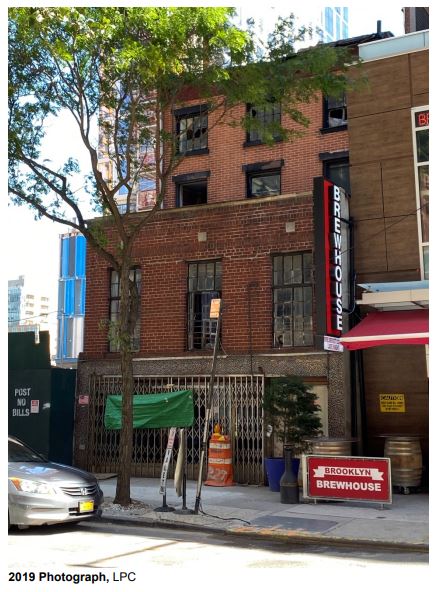
Item 1
LP-2645
Harriet and Thomas Truesdell House – 227 Duffield Street
Item Proposed for Designation as an Individual New York City Landmark
The proposed designation of a Greek Revival‐style row house, constructed c. 1847‐50 and extended in 1933, that was home to abolitionists Harriet and Thomas Truesdell from 1851‐63.
The Historic Districts Council has long been concerned about the permanent preservation of the Harriet and Thomas Truesdell House at 227 Duffield Street in Downtown Brooklyn. The house, dating from the mid-19th century, was home to the Truesdells from 1851 – 1863, and is the home where Harriet died in 1862. The Truesdells were intimately involved in the American Abolitionist movement, befriending such luminaries as Ralph Waldo Emerson and William Lloyd Garrison. The Truesdells were associated with the house until the 1920’s.
Although the building has seen substantial alterations since Harriet and Thomas Truesdell’s residency, the essential truth of the house is still very evident. Visually, this is obviously a home of the mid-19th century. It is one of the few such remaining houses in the area and the only one left on this block after the devastation wrought by the 2004 rezoning. During that action, the history of this building was deeply researched. While its physical connection with Underground Railroad activities was inconclusive, its association with the Truesdells and the Abolitionist movement is unequivocal. This house is the last remaining connection to the dedicated Abolitionist community active in the area in the mid-19th century.
As such, it provides important context to the handful of other known Abolitionist sites of conscience in Brooklyn–such as Plymouth Church of the Pilgrims–by expanding the historic record to include domestic buildings as well as institutional and religious structures. It was not an accident that Henry Ward Beecher became more radicalized and fervent about Abolitionism while serving as pastor in the Plymouth Church of the Pilgrims. The community was fertile ground for the cause, and placing the Truesdells within that history gives us a better perspective of the time and helps correct the fallacious impulse to ascribe one of the most important human rights movements in American history to the Great Man Theory.
It has been estimated that in 1790, a third of Brooklyn’s population were of African origin, the vast majority of whom were enslaved. In 1834, seven years after slavery in New York State ended and the year the City of Brooklyn was incorporated, an anti-abolition riot in Manhattan led many abolitionists to consider moving to Brooklyn. The village of Weeksville, established in 1838 by free Blacks, began to thrive, and the village of Williamsburg became a destination as well.
The history of slavery in Brooklyn and New York City is a field which is still very much emerging. More research needs to be done and much more information needs to be incorporated into the accepted canon of history. As preservationists and historians, we should be doing everything possible to save and record the stories, records and artifacts of that time before they are lost. As much of early American life took place in the domestic realm, especially the organizing and formulation of controversial reform movements such as Abolitionism, the designation of a site of conscience such as 227 Duffield Street as an individual New York City landmark would grant protection to a building which will only grow in importance and significance as our understanding of history expands.
We applaud the Landmarks Preservation Commission for bringing forward this important site for consideration before it is lost for all time. HDC urges the Commission to designate 227 Duffield Street so that future New Yorkers will not forget our city’s complex history.



